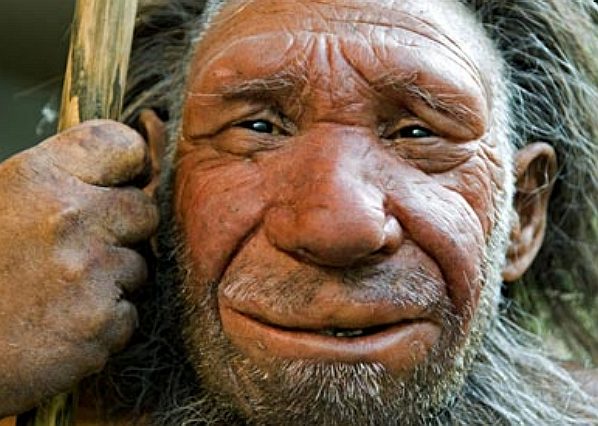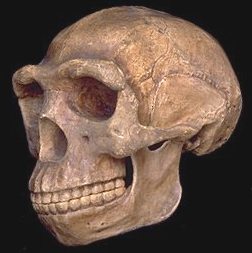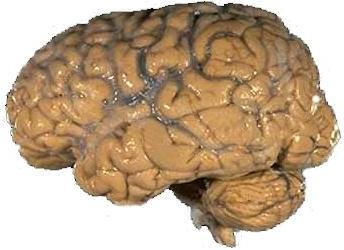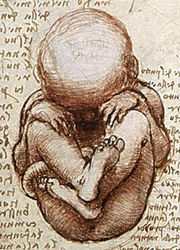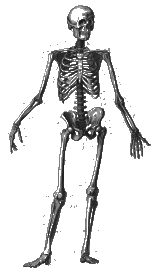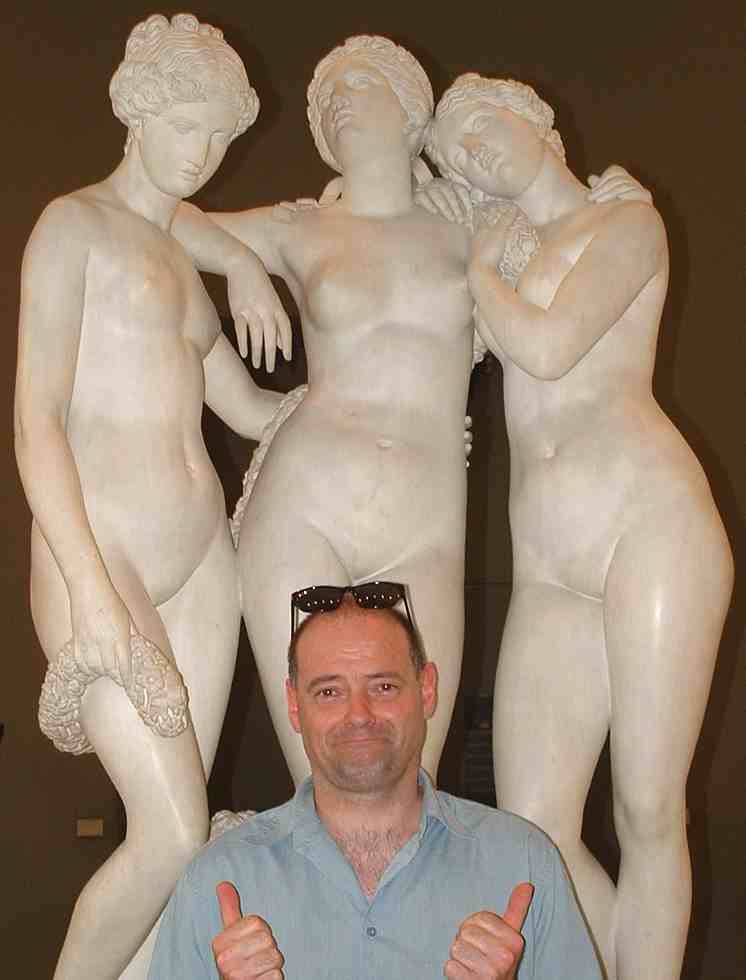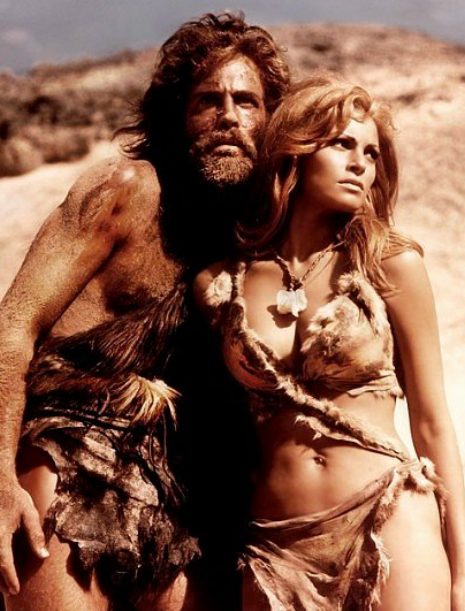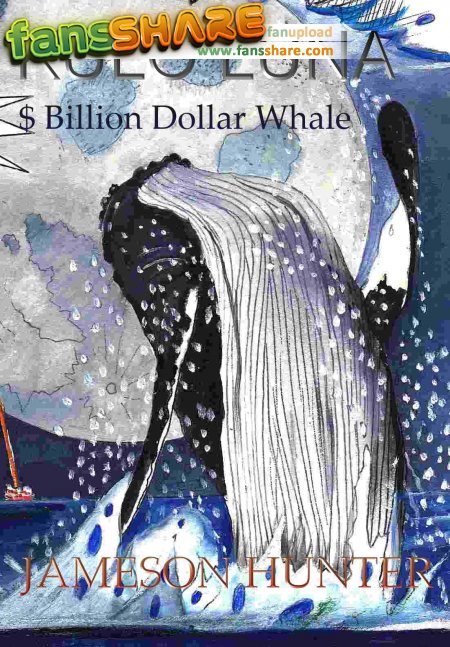|
HUMANS
|
|||||||||||||||||||||||||||||||||||||||||||||||||||||||||||||||||||||
|
Humans, or human beings, are bipedal primates belonging to the mammalian species Homo sapiens (Latin for "wise man" or "knowing man") under the family Hominidae (the great apes). Humans have a highly developed brain capable of abstract reasoning, language and introspection. This, combined with an erect body carriage that frees their upper limbs for manipulating objects, has allowed humans to make greater use of tools than any other species. In other words, we are the lucky ones.
Cousin Bob
Like most primates, humans are by nature social. However, humans are particularly adept at utilizing systems of communication for self-expression and the exchange of ideas. Humans create complex social structures composed of co-operating and competing groups, ranging in scale from nations to individual families, and social interaction between humans has established a variety of traditions, rituals, ethics, values, social norms, and laws which form the basis of human society. Humans also have a marked appreciation for beauty and aesthetics which, combined with the human desire for self-expression, has led to cultural innovations such as art, literature and music.
Humans are also noted for their desire to understand and influence the world around them, seeking to explain and manipulate natural phenomena through science, religion, philosophy and mythology. This natural curiosity has led to the development of advanced tools and skills; humans are the only known species to build fires, cook their food, clothe themselves, and use numerous other technologies.
Human body types vary substantially. Although body size is largely determined by genes, it is also significantly influenced by environmental factors such as diet and exercise. The average height of a North American adult female is 162 centimetres (5 feet 4 inches), and the average weight is 62 kilograms (137 pounds). Human males are typically larger than females: the average height and weight of a North American adult male is 175 centimeters (5 feet 9 inches) and 78 kilograms (172 pounds).
Humans are capable of fully bipedal locomotion, thus leaving their arms available for manipulating objects using their hands, aided especially by opposable thumbs. Because human physiology has not fully adapted to bipedalism, the pelvic region and vertebral column tend to become worn, creating locomotion difficulties in old age.
Although humans appear relatively hairless compared to other primates, with notable hair growth occurring chiefly on the top of the head, underarms and pubic area, the average human has more hair on his or her body than the average chimpanzee. The main distinction is that human hairs are shorter, finer, and less colored than the average chimpanzee's, thus making them harder to see.
Inuit woman, circa 1907
The color of human hair and skin is determined by the presence of pigments called melanins. Human skin color can range from very dark brown to very pale pink, while human hair ranges from blond to brown to red, but most commonly, black. Most researchers believe that skin darkening was an adaptation that evolved as a defense against ultraviolet solar radiation: melanin is an effective sun-block. The skin color of contemporary humans is geographically stratified, and in general correlates with the level of ultraviolet radiation. Human skin also has a capacity to darken (sun tanning) in response to exposure to ultraviolet radiation.
The average sleep requirement is between seven and eight hours a day for an adult and nine to ten hours for a child; elderly people usually sleep for six to seven hours. Negative effects result from restriction of sleep. For instance, a sustained restriction of adult sleep to four hours per day has been shown to correlate with changes in physiology and mental state, including fatigue, aggression, and bodily discomfort. It is common in modern societies for people to get less sleep than they need, leading to a state of sleep deprivation.
Humans are a eukaryotic species. Each diploid cell has two sets of 23 chromosomes, each set received from one parent. There are 22 pairs of autosomes and one pair of sex chromosomes. By present estimates, humans have approximately 20,000–25,000 genes and share 98.4% of their DNA with their closest living evolutionary relatives, the two species of chimpanzees.
Like other mammals, humans have an XY sex-determination system, so that females have the sex chromosomes XX and males have XY. The X chromosome is larger and carries many genes not on the Y chromosome, which means that recessive diseases associated with X-linked genes, such as hemophilia, affect men more often than women.
Cousin Bob is second from the right, behind me
Life cycle
The human life cycle is similar to that of other placental mammals. New humans develop viviparously from conception. An egg is usually fertilized inside the female by sperm from the male through sexual intercourse, though the recent technology of in vitro fertilization is also occasionally used. The fertilized egg, called a zygote, divides inside the female's uterus to become an embryo, which over a period of thirty-eight weeks becomes a human fetus. At birth, the fully-grown fetus is expelled from the female's body and breathes independently as an infant for the first time. At this point, most modern cultures recognize the baby as a person entitled to the full protection of the law, though some jurisdictions extend personhood to human fetuses while they remain in the uterus.
Compared with that of other species, human childbirth is fairly complicated. Painful labors lasting twenty-four hours or more are not uncommon, and may result in injury, or even death, to the child or mother. This is due to both the relatively large fetal head circumference (for housing the brain) and the mother's relatively narrow pelvis (a trait required for successful bipedalism) , by way of natural selection. The chances of a successful labour increased significantly during the 20th century in wealthier countries with the advent of new medical technologies. Natural childbirth remains a common, and relatively dangerous ordeal in unindustrialized regions of the world and for poor people in industrialized regions.
Human children are born after a nine-month gestation period, and are typically 3–4 kilograms (6–9 pounds) in weight and 50–60 centimeters (20–24 inches) in height in developed countries. Helpless at birth, they continue to grow for some years, typically reaching sexual maturity at twelve to fifteen years of age. Human girls continue to grow physically until around the age of eighteen, while human boys continue growing until around the age of twenty-one.
The human life span can be split into a number of stages: infancy, childhood, adolescence, young adulthood, maturity and old age. The lengths of these stages, however—particularly the later ones—are not fixed.
There are striking differences in life expectancy around the world. The developed world is quickly getting older, with the median age around 40 years (highest in Monaco at 45.1 years), while in the developing world, the median age is 15–20 years (lowest in Uganda at 14.8 years). Life expectancy at birth is 77.2 years in the U.S. as of 2001. The expected life span at birth in Singapore is 84.29 years for a female and 78.96 years for a male, while in Botswana, due largely to AIDS, it is 30.99 years for a male and 30.53 years for a female. One in five Europeans, but one in twenty Africans, is 60 years or older.
The number of centenarians (humans 100 years or older) in the world was estimated by the United Nations at 210,000 in 2002. The current maximum life span of humans is about 120 years (Jeanne Calment lived for 122 years and 164 days). Worldwide, there are 81 men aged 60 or older for every 100 women of the same age, and among the oldest, there are 53 men for every 100 women.
The philosophical questions of when human personhood begins and whether it persists after death are the subject of considerable debate. The prospect of death causes unease or fear for most humans. Burial ceremonies are characteristic of human societies, often inspired by beliefs in an afterlife or immortality.
Race and ethnicity
Humans often categorize themselves in terms of race or ethnicity, although the scientific validity of human races as categories is disputed. Human racial categories are based on both ancestry and visible traits, especially skin color and facial features. Ethnic groups, on the other hand, are more often linked by linguistic, cultural, and national or regional ties. Self-identification with an ethnic group is based on kinship and descent. Race and ethnicity can lead to variant treatment and impact social identity, giving rise to the theory of identity politics.
Although most humans recognize that variances occur within a species, it is often a point of dispute as to what these differences entail, their importance, and whether discrimination based on race (racism) is acceptable. Some societies have placed a great deal of emphasis on race, while others have not.
Reconstructed skull of Peking Man, a representative of the extinct species believed to be the nearest ancestor of Homo sapiens, Homo erectus
Evolution
The study of human evolution encompasses the development of the genus Homo, but usually involves studying other hominids and hominines as well, such as the australopithecines. "Modern humans" are defined as the Homo sapiens species, of which the only extant subspecies is Homo sapiens sapiens; Homo sapiens idaltu (roughly translated as "elder wise man"), the other known subspecies, is extinct.
The closest living relatives of Homo sapiens are the Common Chimpanzee and the Bonobo. Full genome sequencing resulted in the conclusion that "After 6.5 [million] years of separate evolution, the differences between chimpanzee and human are just 10 times greater than those between two unrelated people and 10 times less than those between rats and mice." In fact, chimpanzee and human DNA is 96% identical. It has been estimated that the human lineage diverged from that of chimpanzees about five million years ago, and from gorillas about eight million years ago. However, a hominid skull discovered in Chad in 2001, classified as Sahelanthropus tchadensis, is approximately seven million years old, which may indicate an earlier divergence.
There are two prominent scientific theories of the origins of contemporary humans. They concern the relationship between modern humans and other hominids. The single-origin, or "out of Africa", hypothesis proposes that modern humans evolved in Africa and later migrated outwards to replace hominids in other parts of the world. The multiregional hypothesis, on the other hand, proposes that modern humans evolved, at least in part, from independent hominid populations.
Geneticists Lynn Jorde and Henry Harpending of the University of Utah proposed that the variation in human DNA is minute compared to that of other species, and that during the Late Pleistocene, the human population was reduced to a small number of breeding pairs—no more than 10,000—resulting in a very small residual gene pool. Various reasons for this hypothetical bottleneck have been postulated, the most popular being the Toba catastrophe theory.
Human evolution is characterized by a number of important physiological trends, including the expansion of the brain cavity and brain itself, which is typically 1,400 cm³ in volume, over twice that of a chimpanzee or gorilla. The pattern of human postnatal brain growth differs from that of other apes (heterochrony), allowing for an extended period of social learning in juvenile humans. Physical anthropologists argue that a reorganization of the structure of the brain is more important than cranial expansion itself. Other significant evolutionary changes included a reduction of the canine tooth, development of bipedal locomotion, and the descent of the larynx and hyoid bone, making speech possible. How these trends are related and what their role is in the evolution of complex social organization and culture are matters of ongoing debate in the field of physical anthropology.
Habitat and population
The most widely accepted view among current anthropologists is that Homo sapiens originated in the African savanna between 200,000 and 250,000 years ago, descending from Homo erectus, and colonized Eurasia and Oceania by 40,000 years ago, and finally colonized the Americas by 10,000 years ago. They displaced Homo neanderthalensis, Homo floresiensis and other species descended from Homo erectus (which had colonized Eurasia as early as 2 million years ago) through more successful reproduction and competition for resources.
The earliest humans were hunter-gatherers, a lifestyle well-suited to the savanna. Some later groups of humans were nomads, often to facilitate animal herding, and still later humans established permanent settlements, which was made possible by the development of agriculture. Permanent human settlements were dependent on proximity to water and, depending on the lifestyle, other natural resources, such as fertile land for growing crops and grazing livestock, or seasonally by hunting populations of prey. However, humans have a great capacity for altering their habitats by various methods, such as through irrigation, urban planning, construction, transport, and manufacturing goods, and with the advent of large-scale trade and transport infrastructure, proximity to these resources has become unnecessary, and in many places these factors are no longer a driving force behind the growth and decline of a population. Nonetheless, the manner in which a habitat is altered is often a major determinant in population change.
Technology has allowed humans to colonize all of the continents and adapt to all climates. Within the last few decades, humans have explored Antarctica, the ocean depths, and space, although long-term habitation of these environments is not yet possible. With a population of over six billion, humans are among the most numerous of the large mammals. Most humans (61%) live in Asia. The vast majority of the remainder live in the Americas (14%), Africa (13%) and Europe (12%), with 0.5% in Oceania. (
Human habitation within closed ecological systems in hostile environments, such as Antarctica and outer space, is expensive, typically limited in duration, and restricted to scientific, military, or industrial expeditions. Life in space has been very sporadic, with no more than thirteen humans in space at any given time. Between 1969 and 1972, two humans at a time spent brief intervals on the Moon. As of 2006, no other celestial body has been visited by human beings, although there has been a continuous human presence in space since the launch of the initial crew to inhabit the International Space Station on October 31, 2000.
From AD 1800 to 2000, the human population increased from one to six billion. In 2004, around 2.5 billion out of 6.3 billion people (39.7%) lived in urban areas, and this percentage is expected to rise throughout the 21st century. Problems for humans living in cities include various forms of pollution, crime, and poverty, especially in inner city and suburban slums.
Fruit market
Diet
The human diet, similar to most mammals, centers around regular intake of food and drink. It is prominently reflected in human culture, and has led to the development of food science. Failure to obtain food leads to hunger and eventually starvation, while failure to obtain water leads to thirst and dehydration. Both starvation and dehydration cause death if not alleviated. In general, humans can survive for two to eight weeks without food, depending on stored body fat. Survival without water is usually limited to three or four days. In modern times, obesity among some human populations has increased to almost epidemic proportions, leading to health complications and increased mortality in some developed, and, increasingly, in developing countries. The United States Center for Disease Control states that 32% of adults over the age of 20 are obese, while 66.5% are obese or overweight. Obesity is believed to be caused by a number of factors, with many attributing excessive weight gain to overeating.
Humans are animals who can consume both plant and animal products. Most biologists agree humans are omnivorous. A minority believes they are an anatomically herbivorous species, many members of which have begun consuming food of animal origin. Early Homo sapiens employed a "hunter-gatherer" methodology as their primary means of food collection, involving combining stationary plant and fungal food sources (such as fruits, grains, tubers, and mushrooms) with wild game which must be hunted and killed in order to be consumed. Some humans choose to be vegans or vegetarians, abstaining from eating meat for religious, ethical, ecological, or health reasons. It is believed that humans have used fire to prepare and cook food prior to eating since the time of their divergence from Homo erectus - possibly even earlier.
At least ten thousand years ago, humans developed agriculture, which has substantially altered the kind of food people eat. This has led to increased populations, the development of cities, and, due to increased population density, the wider spread of infectious diseases. The types of food consumed, and the way in which they are prepared, has varied widely by time, location, and culture.
The last century or so has produced enormous improvements in food production, preservation, storage and shipping. Today almost every locale in the world has access to not only its traditional cuisine, but many other world cuisines.
The human brain
Brain, mind, and consciousness
The human brain is the center of the central nervous system in humans, as well as the primary control center for the peripheral nervous system. The brain controls "lower", or involuntary, autonomic activities such as heart rate, respiration, and digestion. The brain also controls "higher" order, conscious activities, such as thought, reasoning, and abstraction. The human brain is generally regarded as more capable of these higher order activities, and more "intelligent" in general, than any other species. While other animals are capable of creating structures and using simple tools—mostly as a result of instinct and learning through mimicry—human technology is vastly more complex, constantly evolving and improving with time. Even the most ancient human tools and structures are far more advanced than any structure or tool created by any other animal.
The human ability to think abstractly may be unparalleled in the animal kingdom. Human beings are one of only six species to pass the mirror test - which tests whether an animal recognizes its reflection as an image of itself—along with chimpanzees, bonobos, orangutans, dolphins and pigeons. Human beings under the age of 2 typically fail this test. However, this may be a matter of degree rather than a sharp divide. Monkeys have been trained to apply abstract rules in tasks.
The brain perceives the external world through the senses, and each individual human is influenced greatly by his or her experiences, leading to subjective views of existence and the passage of time.
Humans are variously said to possess consciousness, self-awareness, and a mind, which correspond roughly to the mental processes of thought. These are said to possess qualities such as self-awareness, sentience, sapience, and the ability to perceive the relationship between oneself and one's environment. The extent to which the mind constructs or experiences the outer world is a matter of debate, as are the definitions and validity of many of the terms used above. Cognitive scientist Daniel Dennett, for example, argues that there is no such thing as a narrative centre called the "mind", but that instead there is simply a collection of sensory inputs and outputs: different kinds of "software" running in parallel.
Humans study the more physical aspects of the mind and brain, and by extension of the nervous system, in the field of neurology, the more behavioral in the field of psychology, and a sometimes loosely-defined area between in the field of psychiatry, which treats mental illness and behavioral disorders. Psychology does not necessarily refer to the brain or nervous system, and can be framed purely in terms of phenomenological or information processing theories of the mind. Increasingly, however, an understanding of brain functions is being included in psychological theory and practice, particularly in areas such as artificial intelligence, neuropsychology, and cognitive neuroscience.
The nature of thought is central to psychology and related fields. Cognitive psychology studies cognition, the mental processes underlying behavior. It uses information processing as a framework for understanding the mind. Perception, learning, problem solving, memory, attention, language and emotion are all well-researched areas as well. Cognitive psychology is associated with a school of thought known as cognitivism, whose adherents argue for an information processing model of mental function, informed by positivism and experimental psychology. Techniques and models from cognitive psychology are widely applied and form the mainstay of psychological theories in many areas of both research and applied psychology. Largely focusing on the development of the human mind through the life span, developmental psychology seeks to understand how people come to perceive, understand, and act within the world and how these processes change as they age. This may focus on intellectual, cognitive, neural, social, or moral development.
Social psychology links sociology with psychology in their shared study of the nature and causes of human social behavior, with an emphasis on how people think towards each other and how they relate to each other. The behavior and mental processes of animals, both human and non-human, can be described through animal cognition, ethology, evolutionary psychology, and comparative psychology as well. Human ecology is an academic discipline that investigates how humans and human societies interact with both their natural environment and the human social environment.
Human foetus in the womb
Complete scientific classification
The complete scientific classification of the modern human consists of many sub- and super- sections to the basic chart:
Eukaryota (Domain) Animalia (Kingdom) Eumetazoa (Subregnum) Bilateria [having bilateral symmetery) Deuterostomia (Superphylum) Chordate (Phylum) Craniata [animals with skulls] Vertebrata (Subphylum) [...and backbones] Gnathostomata (Infraphylum) [...and jaws] Teleostomi [advanced fish and decendants] Tetrapoda (Superclass) [...and four legs] Amniota (Series) [...and amniotic eggs] Synapsida [mammal-like reptiles] Mammaliaformes Mammalia (Class) [all mammals] Eutheria (Subclass) Euarchontoglires (Superorder) Euarchonta (Superorder) Primates (Order) Haplorrhini (Suborder) Simiiformes (Infraorder) Catarrhini (Parvorder) Hominoidea (Superfamily) Hominidae (Family) Homininae (Subfamily) Hominini (Tribe) Hominina (Subtribe) Homo (Genus) Homo Sapiens (Species) Homo Sapiens Sapiens (Subspecies)
Society and culture
Society is here defined as the organizations and institutions arising from interaction between humans, while culture is defined here as a set of distinctive material, intellectual, emotional, and spiritual features of a social group, including art, literature, lifestyles, value systems, traditions, rituals, and beliefs. The link between human biology and human behavior and culture is often very close, making it difficult to clearly divide topics into one area or the other; as such, the placement of some subjects may be based on convention more than reality.
Culture and society consist of values, social norms, and artifacts. A culture's values define what it holds to be important or ethical. Closely linked are norms, expectations of how people ought to behave, bound by tradition. Artifacts, or "material culture", are objects derived from the culture's values, norms, and understanding of the world. Language
The capacity for humans to share ideas is unrivaled in known species. The faculty of speech is a defining feature of humanity, possibly predating phylogenetic separation of the modern population (see origin of language). Language is central to the communication between humans, as well as being central to the sense of identity that unites nations, cultures and ethnic groups.
The invention of writing systems around 5000 years ago allowed the preservation of language on material objects, and was a major step in cultural evolution. Language is closely tied to ritual and religion (c.f. mantra, sacred text).
The science of linguistics describes the structure of language and the relationship between languages. There are estimated to be approximately 6,000 different languages, including sign languages, currently in use, and many thousands more that are considered extinct.
Joseph - detail from Caravaggio's Rest on Flight to Egypt (ca. 1594)
Art, music and literature
Artistic works have existed for almost as long as humankind, from early pre-historic art to contemporary art. Art is one of the most unusual aspects of human behavior and a key distinguishing feature of humans from other species.
As a form of cultural expression by humans, art may be defined by the pursuit of diversity and the usage of narratives of liberation and exploration (i.e. art history, art criticism, and art theory) to mediate its boundaries. This distinction may be applied to objects or performances, current or historical, and its prestige extends to those who made, found, exhibit, or own them.
In the modern use of the word, art is commonly understood to be the process or result of making material works which, from concept to creation, adhere to the "creative impulse"—that is, art is distinguished from other works by being in large part unprompted by necessity, by biological drive, or by any undisciplined pursuit of recreation.
Music is a natural intuitive phenomenon based on the three distinct and interrelated organization structures of rhythm, harmony, and melody. Listening to music is perhaps the most common and universal form of entertainment for humans, while learning and understanding it are popular disciplines. There are a wide variety of music genres and ethnic musics.
Literature, the body of written—and possibly oral—works, especially creative ones, includes prose, poetry and drama, both fiction and non-fiction. Literature includes such genres as epic, legend, myth, ballad, and folklore.
Human skeleton
Motivation and emotion
Motivation is the driving force of desire behind all actions of any organism. Motivation is based on emotion—specifically, on the search for satisfaction (positive emotional experiences), and the avoidance of conflict; positive and negative are defined by the individual brain state, not by social norms: a person may be driven to self-injury or violence because their brain is conditioned to create a positive response to these actions. Motivation is important because it is involved in the performance of all learned responses.
Within psychology, conflict avoidance and the libido are seen to be primary motivators. Within economics motivation is often seen to be based on Financial incentives, Moral incentives, or Coercive incentives. Religions generally posit Godly or demonic influences.
Happiness, or being happy, is a human emotional condition. The definition of happiness is a common philosophical topic. Some people might define it as the best condition which a human can have—a condition of mental and physical health. Others may define it as freedom from want and distress; consciousness of the good order of things; assurance of one's place in the universe or society, inner peace, and so forth.
Human emotion has a significant influence on, or can even be said to control, human behavior. Emotional experiences perceived as pleasant, like love, admiration, or joy, contrast with those perceived as unpleasant, like hate, envy, or sorrow. There is often a distinction seen between refined emotions, which are socially learned, and survival oriented emotions, which are thought to be innate.
Human exploration of emotions as separate from other neurological phenomena is worthy of note, particularly in those cultures where emotion is considered separate from physiological state. In some cultural medical theories, to provide an example, emotion is considered so synonymous with certain forms of physical health that no difference is thought to exist. The Stoics believed excessive emotion was harmful, while some Sufi teachers (in particular, the poet and astronomer Omar Khayyám) felt certain extreme emotions could yield a conceptual perfection, what is often translated as ecstasy.
In modern scientific thought, certain refined emotions are considered to be a complex neural trait of many domesticated and a few non-domesticated mammals, developed commonly in reaction to superior survival mechanisms and intelligent interaction with each other and the environment; as such, refined emotion is not in all cases as discrete and separate from natural neural function as was once assumed. Still, when humans function in civilized tandem, it has been noted that uninhibited acting on extreme emotion can lead to social disorder and crime.
Love and sexuality
Vestal Virgins statue - The Louvre, Paris
Human sexuality, besides ensuring biological reproduction, has important social functions: it creates physical intimacy, bonds and hierarchies among individuals; may be directed to spiritual transcendence; and in a hedonistic sense to the enjoyment of activity involving sexual gratification. Sexual desire, or libido, is experienced as a bodily urge, often accompanied by strong emotions such as love, ecstasy and jealousy.
As with other human self-descriptions, humans propose that it is high intelligence and complex societies of humans that have produced the most complex sexual behaviors of any animal, including a great many behaviors that are not directly connected with reproduction.
Human sexual choices are usually made in reference to cultural norms, which vary widely. Restrictions are sometimes determined by religious beliefs or social customs.
Many sexologists believe that the majority of homo sapiens have the inherent capacity to be attracted to both males and females (a kind of universal potential bisexuality). In a variation of this, pioneering researcher Sigmund Freud believed that humans are born polymorphously perverse, which means that any number of objects could be a source of pleasure. According to Freud, we then pass through five stages of psychosexual development (and can fixate on any stage due to various traumas during the process). For Alfred Kinsey, another influential sex researcher, people can fall anywhere along a continuous scale of sexual orientation (with only small minorities fully heterosexual or homosexual). Recent studies of neurology and genetics may suggest people may be born with one sexual orientation or another, so there is not currently a clear consensus among sex researchers.
Spirituality and religion
Spirituality, belief or involvement in matters of the soul or spirit, is one of the many different approaches humans take in trying to answer fundamental questions about mankind's place in the universe, the meaning of life, and the ideal way to live one's life. Though these topics have also been addressed by philosophy, and to some extent by science, spirituality is unique in that it focuses on mystical or supernatural concepts such as karma and God.
A more organized, but related, concept is Religion—sometimes used interchangeably with "faith"—which is commonly defined as a belief system concerning the supernatural, sacred, or divine, and the moral codes, practices, values, institutions and rituals associated with such belief. In the course of its development, religion has taken on many forms that vary by culture and individual perspective.
Some of the chief questions and issues religions are concerned with include life after death (commonly involving belief in an afterlife), the origin of life (the source of a variety of origin beliefs), the nature of the universe (religious cosmology) and its ultimate fate (eschatology), and what is moral or immoral. A common source in religions for answers to these questions are transcendent divine beings such as deities or a singular God, although not all religions are theistic - many are nontheistic or ambiguous on the topic, particularly among the Eastern religions.
Although a majority of humans profess some variety of spiritual or religious belief, some are irreligious, lacking or rejecting belief in the supernatural or spiritual. Additionally, although most religions and spiritual beliefs are clearly distinct from science on both a philosophical and methodological level, the two are not generally considered to be mutually exclusive; a majority of humans hold a mix of both scientific and religious views. The distinction between philosophy and religion, on the other hand, is at times less clear, and the two are linked in such fields as the philosophy of religion and theology.
Plato and Aristotle in detail from Raphael's School of Athens
Philosophy and self-reflection
Philosophy is a discipline or field of study involving the investigation, analysis, and development of ideas at a general, abstract, or fundamental level. It is the discipline searching for a general understanding of values and reality by chiefly speculative, rather than observational, means.
The core philosophical disciplines are logic, ontology or metaphysics, epistemology, and axiology, which includes the branches of ethics and aesthetics. Philosophy covers a very wide range of approaches, and is also used to refer to a worldview, to a perspective on an issue, or to the positions argued for by a particular philosopher or school of philosophy.
Metaphysics is a branch of philosophy concerned with the study of first principles, being and existence (ontology). In between the doctrines of religion and science, stands the philosophical perspective of metaphysical cosmology. This ancient field of study seeks to draw logical conclusions about the nature of the universe, humanity, god, and/or their connections based on the extension of some set of presumed facts borrowed from religion and/or observation.
Humans often consider themselves to be the dominant species on Earth, and the most advanced in intelligence and ability to manage their environment. This belief is especially strong in modern Western culture. Alongside such claims of dominance is often found radical pessimism because of the frailty and brevity of human life.
Humanism is a philosophy which defines a socio-political doctrine the bounds of which are not constrained by those of locally developed cultures, but which seeks to include all of humanity and all issues common to human beings. Because spiritual beliefs of a community often manifests as religious doctrine, the history of which is as factious as it is unitive, secular humanism grew as an answer to the need for a common philosophy that transcended the cultural boundaries of local moral codes and religions. Many humanists are religious, however, and see humanism as simply a mature expression of a common truth present in most religions. Humanists affirm the possibility of an objective truth and accept that human perception of that truth is imperfect. The most basic tenets of humanism are that humans matter and can solve human problems, and that science, freedom of speech, rational thought, democracy, and freedom in the arts are worthy pursuits or goals for all peoples. Humanism depends chiefly on reason and logic without consideration for the supernatural.
Humans achieved a level of technological mastery sufficient to leave the atmosphere of Earth in the 20th century (Alexei Leonov on the first ever walk in space)
Science and technology
Human cultures are both characterized and differentiated by the objects that they make and use. Archaeology attempts to tell the story of past or lost cultures in part by close examination of the artifacts they produced. Early humans left stone tools, pottery and jewelry that are particular to various regions and times.
Improvements in technology are passed from one culture to another. For instance, the cultivation of crops arose in several different locations, but quickly spread to be an almost ubiquitous feature of human life. Similarly, advances in weapons, architecture and metallurgy are quickly disseminated.
Such techniques can be passed on by oral tradition. The development of writing, itself a kind of technology, made it possible to pass information from generation to generation and from region to region with greater accuracy.
Together, these developments made possible the commencement of civilization and urbanization, with their inherently complex social arrangements. Eventually this led to the institutionalization of the development of new technology, and the associated understanding of the way the world functions. This science now forms a central part of human culture.
In recent times, physics and astrophysics have come to play a central role in shaping what is now known as physical cosmology, that is, the understanding of the universe through scientific observation and experiment. This discipline, which focuses on the universe as it exists on the largest scales and at the earliest times, begins by arguing for the big bang, a sort of cosmic explosion from which the universe itself is said to have erupted ~13.7 ± 0.2 billion (109) years ago. After its violent beginnings and until its very end, scientists then propose that the entire history of the universe has been an orderly progression governed by physical laws.
Government and politics
A state is an organized political community occupying a definite territory, having an organized government, and possessing internal and external sovereignty. Recognition of the state's claim to independence by other states, enabling it to enter into international agreements, is often important to the establishment of its statehood. The "state" can also be defined in terms of domestic conditions, specifically, as conceptualized by Max Weber, "a state is a human community that (successfully) claims the monopoly of the 'legitimate' use of physical force within a given territory."
Government can be defined as the political means of creating and enforcing laws; typically via a bureaucratic hierarchy.
Politics is the process by which decisions are made within groups. Although the term is generally applied to behavior within governments, politics is also observed in all human group interactions, including corporate, academic, and religious institutions. Many different political systems exist, as do many different ways of understanding them, and many definitions overlap. The most common form of government worldwide is a republic, however other examples include monarchy, social democracy, military dictatorship and theocracy.
All of these issues have a direct relationship with economics.
The atomic bombings of Hiroshima and Nagasaki effectively ended World War II and immediately killed over 120,000 human beings
War
War is a state of widespread conflict between states, organizations, or relatively large groups of people, which is characterized by the use of lethal violence between combatants or upon civilians.
A common perception of war is a series of military campaigns between at least two opposing sides involving a dispute over sovereignty, territory, resources, religion or other issues. A war said to liberate an occupied country is sometimes characterized as a "war of liberation", while a war between internal elements of a state is a civil war.
There have been a wide variety of rapidly advancing tactics throughout the history of war, ranging from conventional war to asymmetric warfare to total war and unconventional warfare. Techniques have nearly always included hand to hand combat, the usage of ranged weapons, propaganda, Shock and Awe, and ethnic cleansing. Military intelligence has always played a key role in determining victory and defeat. In modern warfare, soldiers and armored fighting vehicles are used to control the land, warships the seas, and air power the skies. Outer space has recently become an important factor in warfare as well, although no actual warfare is currently carried out within space.
Throughout history there has been a constant struggle between defense and offense, armor, and the weapons designed to breach it. Modern examples include the bunker buster bomb, and the bunkers which they are designed to destroy.
Trade and economics
Trade is the voluntary exchange of goods, services, or both, and a form of economics. A mechanism that allows trade is called a market. The original form of trade was barter, the direct exchange of goods and services. Modern traders instead generally negotiate through a medium of exchange, such as money. As a result, buying can be separated from selling, or earning. The invention of money (and later credit, paper money and non-physical money) greatly simplified and promoted trade.
Trade exists for many reasons. Due to specialization and division of labor, most people concentrate on a small aspect of manufacturing or service, trading their labour for products. Trade exists between regions because different regions have an absolute or comparative advantage in the production of some tradable commodity, or because different regions' size allows for the benefits of mass production. As such, trade between locations benefits both locations.
Economics is a social science that studies the production, distribution, trade and consumption of goods and services.
Economics, which focuses on measurable variables, is broadly divided into two main branches: microeconomics, which deals with individual agents, such as households and businesses, and macroeconomics, which considers the economy as a whole, in which case it considers aggregate supply and demand for money, capital and commodities. Aspects receiving particular attention in economics are resource allocation, production, distribution, trade, and competition. Economic logic is increasingly applied to any problem that involves choice under scarcity or determining economic value. Mainstream economics focuses on how prices reflect supply and demand, and uses equations to predict consequences of decisions.
Human society statistics
SOME PROMINENT MISCARRIAGES OF JUSTICE:
LINKS
OTHER ANIMALS:
A heartwarming adventure: Pirate whalers V Conservationists, with an environmental message. Planned for release as an e-book in 2014 with hopes for a film in 2015 TBA
|
|||||||||||||||||||||||||||||||||||||||||||||||||||||||||||||||||||||
|
This web<>site is Copyright © 1999 & 2014. The bird logos and name Solar Navigator and Solar Cola are trademarks. All rights reserved. All other trademarks are hereby acknowledged. Max Energy Limited is an educational charity working hard for world peace.
|
